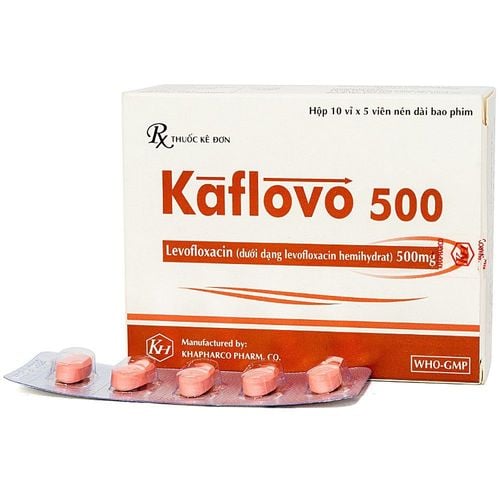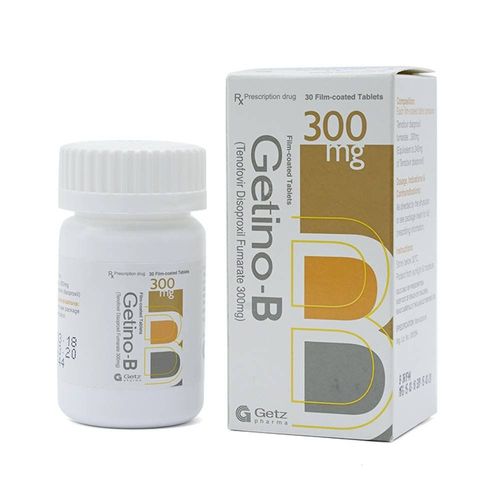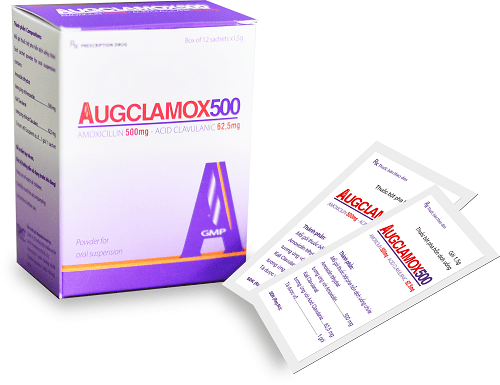This is an automatically translated article.
Sanclary is the brand name of the antibiotic Clarithromycin, made in the form of film-coated tablets. Let's learn more about the uses, dosage, side effects and notes when using Sanclary through the article below.1. What is Sanclary?
Sanclary contains the active ingredient Clarithromycin, which is an antibiotic belonging to the macrolide group.
1.1. Pharmacodynamics of drugs
Clarithromycin is a semi-synthetic macrolide antibiotic. Clarithromycin differs from erythromycin by the methoxy substituent at position C-6 of the macrolide ring. This structural change helps Clarithromycin to expand the antibacterial spectrum, increase its concentration in tissues, increase bioavailability and reduce adverse effects on the digestive system.
Clarithromycin exhibits antibacterial action by binding to the 50S ribosomal subunit of susceptible bacteria at a specific site, thereby inhibiting bacterial protein synthesis. The minimum inhibitory concentration of Clarithromycin is 2-4 times lower than that of Erythromycin. The antibacterial activity of the 14 - hydroxy metabolite of Clarithromycin was also stronger against Haemophilus influenzae.
Clarithromycin is a broad-spectrum antibiotic, active against both gram-positive or gram-negative bacteria, aerobic or anaerobic bacteria, including bacteria such as Staphylococcus aureus (Staphylococcus aureus), Group A Beta Hemolytic Streptococcus (group A ß hemolytic streptococcus), Streptococcus pneumoniae (pneumococcus), Listeria monocytogenes, Haemophilus influenzae, Moraxella catarrhalis, Helicobacter pylori, Neisseria gonorrhoeae, Campylobacter jejuni, Clostridium perfringens, Mycoplasma pneumoniae,... In addition, Clarithromycin also effective on other microorganisms such as: Chlamydia trachomatis, Toxoplasma gondii; Mycobacterium,...
1.2. Pharmacokinetics of the drug
Absorption: When taking Sanclary, Clarithromycin is rapidly absorbed from the gastrointestinal tract. Food does not affect the bioavailability of the drug. Distribution: The major metabolite is 14 - hydroxy clarithromycin. The maximum concentrations of clarithromycin and 14 - hydroxy clarithromycin after oral administration of 250 mg of clarithromycin were 0.6 mcg/l and 0.7 mcg/l, respectively. Clarithromycin and its metabolites are widely distributed, with higher concentrations in tissues than in blood. At therapeutic doses, the rate of protein binding of Clarithromycin is 80%. Clarithromycin also penetrates the gastric mucosa, especially the concentration of the drug in the gastric mucosal layer increases when combined with Omeprazole. Metabolism and Excretion: Clarithromycin is metabolized mainly in the liver. Clarithromycin is excreted in feces and urine. The half-lives of Clarithromycin after 250 mg twice daily and 500 mg twice daily doses are 3-4 hours and 5-7 hours, respectively.
2. Indications of the drug Sanclary
Sanclary (Clarithromycin) is indicated for the treatment of infections with susceptible bacteria in the following cases:
Respiratory infections: Pharyngitis, tonsillitis, sinusitis, otitis media, acute or chronic bronchitis, inflammation Community-acquired pneumonia, Mycoplasma pneumoniae, Legionella pneumonia, diphtheria, pertussis (early stage). Mild to moderate skin and soft tissue infections. Gastric and duodenal ulcers caused by Helicobacter pylori (HP) infection (usually in combination with drugs that inhibit gastric acid secretion). Mycobacterium opportunistic infections in HIV patients
3. Dosage and how to use Sanclary
Use Sanclary by mouth as prescribed and directed by your doctor. Sanclary can be taken before or after meals.
Reference dosage of Clarithromycin for adults and children over 12 years old:
Respiratory infections, skin and soft tissue infections: The usual dose is 250mg / time x 2 times / day, taking the drug for 7 days. For severe infections, the dose can be increased to 500mg/time x 2 times/day, the duration of the drug can be extended up to 14 days. Gastric ulcer - duodenal ulcer due to HP infection: Depending on the combination treatment regimen, Clarithromycin is used at a reasonable dose to ensure the duration of treatment. Mycobacterium infections: the starting dose of Clarithromycin is 500mg/time x 2 times/day, treatment for 3-4 weeks. The dose may be adjusted if the initial dose is not effective. For patients with severe renal impairment (creatinine clearance less than 30ml/min), the total daily dose of Clarithromycin should be halved, the duration of treatment should not exceed 14 days.
4. Contraindications to the drug Sanclary
Sanclary is contraindicated in the following cases:
People with a history of hypersensitivity to Clarithromycin, or other macrolide antibiotics; People with a history of allergy to other ingredients of the drug. The person is taking any of the following: The following: Ergotamine, Cisapride, Terfenadine, Pimozide. People with a history of heart disease or electrolyte disturbances. For pregnant and lactating women, the safety of Clarithromycin has not been established. Therefore, Clarithromycin should not be used during pregnancy or lactation unless the benefits outweigh the risks.
5. Sanclary drug interactions
As with other macrolide antibiotics, concomitant administration of Clarithromycin with drugs that are metabolized by cytochrome P450 (such as Warfarin, Ergot alkaloids, Triazolam, Disopyramide, Phenytoin, Lovastatin, Cyclosporin) increases the concentration of these drugs in serous. Administration of Clarithromycin in patients receiving Warfarin enhances the effects of Warfarin. Therefore, if concomitant use of these two drugs is required, prothrombin time should be regularly monitored. The effect of Digoxin is also increased when used with Clarithromycin. In this case, serum digoxin levels should be monitored. Clarithromycin also alters the metabolism of Terfenadine, increasing the concentration of Terfenadine, accompanied by symptoms of arrhythmia. Clarithromycin is therefore contraindicated in patients receiving terfenadine, or any non-sedating antihistamine such as Astemizole. In patients receiving Theophylline, Clarithromycin increased serum Theophylline concentrations and drug toxicity. Co-administration of clarithromycin and zidovudine in HIV-infected adults reduces steady-state concentrations of zidovudine. Therefore, it is advisable to arrange the time of taking these two drugs 1-2 hours apart. Concomitant administration of Clarithromycin and Omeprazole may increase their plasma concentrations, but no dose adjustment is required. Clarithromycin concentrations are also increased with concomitant use of Ranitidine. In addition, clarithromycin may also increase the potency of carbamazepine by decreasing the rate of excretion.
6. Sanclary drug side effects
Clarithromycin is generally well tolerated. The reported side effects are nausea, vomiting, diarrhea, abdominal pain,... In addition, patients taking Sanclary may experience some less common side effects such as:
Stomatitis, glossitis , glomerulonephritis, granulomatous in the mouth. Allergic reactions of varying degrees: urticaria, rash, anaphylactic reactions, even Stevens-Johnson syndrome in particular hypersensitivity. Reversible loss of taste or color of tongue (when clarithromycin and Omeprazole are combined) Transient CNS side effects: headache, dizziness, anxiety, insomnia, hallucinations, confusion gods, nightmares, confusion. Hearing loss (usually reversible upon discontinuation of the drug). Pseudomembranous colitis ranges from mild to life-threatening. Hepatic dysfunction (usually reversible): Liver dysfunction, hepatitis and biliary tract infection, with or without jaundice.
7. Precautions while using Sanclary
Caution should be taken when using Sanclary in patients with hepatic impairment, in patients with renal impairment, because the liver and kidneys are involved in the metabolism and excretion of the drug. Pay attention to the duration of clarithromycin use as well as repeated use of the drug, because overuse of the drug can lead to drug-resistant bacteria or fungal growth. If bacterial or fungal superinfection occurs after clarithromycin administration, the drug should be discontinued and therapy adjusted as appropriate. Clarithromycin should be used with extreme caution in patients receiving drugs that are metabolised by P450 because of the potential for increased serum concentrations of these drugs. In summary, Sanclary is an oral antibiotic belonging to the macrolide group with a broad spectrum of action. Sanclary is a prescription drug, the use of which is prescribed by a doctor in each specific case. Clarithromycin can interact with other drugs or cause unwanted effects, so patients need to recognize abnormal symptoms early in the course of taking the drug and notify the doctor immediately for timely treatment. .













